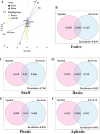Distribution patterns and driving mechanisms of ciliate communities from continental shelf to deep basin of the Northeastern South China Sea
- PMID: 40809807
- PMCID: PMC12343036
- DOI: 10.1093/plankt/fbaf020
Distribution patterns and driving mechanisms of ciliate communities from continental shelf to deep basin of the Northeastern South China Sea
Abstract
Ciliates are common components of microplankton and play crucial roles in the marine microbial food web, but little is known regarding how community assembly and species association vary from shelf to basin. A survey of ciliate diversity was conducted in the northeastern South China Sea during the winter of 2013, and the spatial distribution, driving mechanisms and network relationships of ciliate community were revealed. Our results showed that ciliate community compositions were similar between continental shelf and basin areas but significantly different between photic and aphotic waters. Higher ciliate abundances were found in shelf and photic waters than in basin and aphotic waters, primarily due to differences in light, nutrients and food resources. Across the entire sea area, environmental factors had a more significant influence on communities than spatial factors, suggesting that deterministic processes played a significant role in ciliate distribution. Co-occurrence network analysis revealed that ciliate networks were more stable in basin and photic waters than in shelf and aphotic waters, which was probably related to more complex relationships in the former two waters. Combined with the broader niche breadth, our study suggested that the ciliate community in basin and photic waters would show a stronger defense capability against environmental changes.
Keywords: co-occurrence network; community assembly; diversity; microzooplankton; protozoa.
© The Author(s) 2025. Published by Oxford University Press.
Figures





Similar articles
-
Spatial heterogeneity dominates bacterial biogeography in the surface waters from the South China Sea by structuring environmental gradients.Microbiol Spectr. 2025 Aug 12:e0087525. doi: 10.1128/spectrum.00875-25. Online ahead of print. Microbiol Spectr. 2025. PMID: 40792505
-
Effects of temporal, spatial, and environmental factors on ciliates community in northeastern South China Sea, with notes on co-occurrence patterns of environment, phytoplankton, and ciliate.Microbiol Spectr. 2025 Jan 7;13(1):e0124724. doi: 10.1128/spectrum.01247-24. Epub 2024 Nov 29. Microbiol Spectr. 2025. PMID: 39611825 Free PMC article.
-
Underlying mechanisms of spatial distribution of prokaryotic community in surface seawater from Arctic Ocean to the Sea of Japan.Microbiol Spectr. 2025 Jul;13(7):e0051725. doi: 10.1128/spectrum.00517-25. Epub 2025 May 30. Microbiol Spectr. 2025. PMID: 40444437 Free PMC article.
-
Systemic pharmacological treatments for chronic plaque psoriasis: a network meta-analysis.Cochrane Database Syst Rev. 2017 Dec 22;12(12):CD011535. doi: 10.1002/14651858.CD011535.pub2. Cochrane Database Syst Rev. 2017. Update in: Cochrane Database Syst Rev. 2020 Jan 9;1:CD011535. doi: 10.1002/14651858.CD011535.pub3. PMID: 29271481 Free PMC article. Updated.
-
Comparison of self-administered survey questionnaire responses collected using mobile apps versus other methods.Cochrane Database Syst Rev. 2015 Jul 27;2015(7):MR000042. doi: 10.1002/14651858.MR000042.pub2. Cochrane Database Syst Rev. 2015. PMID: 26212714 Free PMC article.
References
-
- Cai, Z., Gan, J., Liu, Z., Hui, C. R. and Li, J. (2020) Progress on the formation dynamics of the layered circulation in the South China Sea. Prog. Oceanogr., 181, 102246. 10.1016/j.pocean.2019.102246. - DOI
-
- Coppellotti, O. and Matarazzo, P. (2000) Ciliate colonization of artificial substrates in the lagoon of Venice. J. Mar. Biol. Assoc. U. K., 80, 419–427. 10.1017/S0025315400002113. - DOI
-
- Dai, M., Meng, F., Tang, T., Kao, S., Lin, J., Chen, J., Huang, J., Tian, J. et al. (2009) Excess total organic carbon in the intermediate water of the South China Sea and its export to the North Pacific. Geochem. Geophys. Geosyst., 10, 2009GC002752. 10.1029/2009GC002752. - DOI
-
- Ding, X., Liu, J., Zhang, H., Ke, Z., Li, J., Liu, W., Li, K., Zhao, C. et al. (2022) Phytoplankton community patterns in the Northeastern South China Sea: implications of intensified Kuroshio intrusion during the 2015/16 El Niño. J. Geophys. Res. Oceans, 127, e2021JC017998. 10.1029/2021JC017998. - DOI
LinkOut - more resources
Full Text Sources

